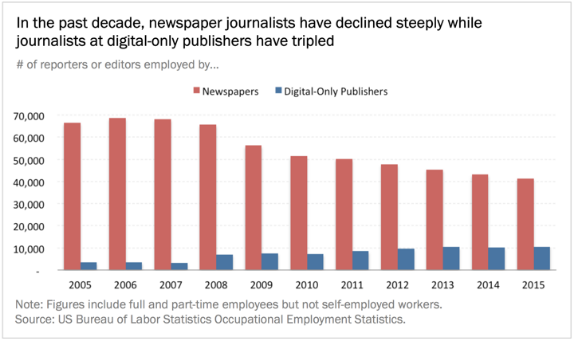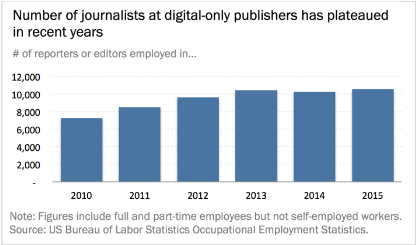It probably comes as no surprise that jobs for journalists at newspapers continue to disappear. But in a disturbing development, digital news jobs that had been replacing some of the legacy positions appear to have hit a plateau.
Earlier this year, the Bureau of Labor Statistics released a chart showing the total number of employees working in the newspaper industry is now lower than those working in the “internet publishing and broadcasting” sector. Given the struggles of the newspaper industry, and the increasing popularity of “digital native” news publishers, such figures may seem intuitive. Yet it only captures how many employees work in these industries–not how many journalists.
With digital native websites becoming more prominent, it is worth exploring how many journalists work in this sector and whether its growth is likely to offset losses in the newspaper industry. Because the American Society of News Editors (ASNE) recently announced it will no longer estimate the size of the newspaper workforce, and no organization surveys digital outlets to measure the size of its workforce, I sought out a new data source to explore these figures.
Based on my analysis of data from the Bureau of Labor Statistics’ Occupational Employment Statistics (OES) program, the number of journalists at digital native publishers has more than tripled in the past decade. This growth, however, pales in comparison to the number of journalists laid off in the newspaper industry. And in recent years, the number of journalists at digital-only publishers seems to have actually plateaued. With fewer journalists working today, reporters are becoming increasingly concentrated in coastal cities, investigative journalism and local statehouse reporting is declining, and the ratio of journalists to public relations specialists is widening.
Previously, the Pew Research Center’s census of editorial staff at digital native news publishers estimated there were about 5,000 full-time staff members in 2014. This in-depth analysis provides important insight, but it is unable to speak to longitudinal trends.
As a PhD student at the University of Pennsylvania, I used data from the OES to compare the number of journalists at digital-only publishers and newspapers over time. This program collects data from about 200,000 employers, which represent 340 types of industries, to annually catalog the structure of the American workforce. Unlike Pew’s 2014 census or the ASNE, the OES figures include both full-time and part-time employees.
In 2005, for every one digital-only journalist, there were 20 newspaper journalists. In 2015, for every one digital-only journalist, there were four newspaper journalists.
According to OES data, the number of journalists in the newspaper industry declined sharply in the past decade. Consider that in 2005, there were 66,490 newspaper reporters or editors. In 2015, there were 41,400, a decline of 25,090 journalists, or 38 percent. During the same time period, the number of journalists at digital-only publishers more than tripled, growing from 3,410 to 10,580.

Source: Bureau of Labor Statistics Occupational Employment Statistics
Put another way, in 2005, for every one digital-only journalist, there were 20 newspaper journalists. But due to steep job losses at newspapers and substantial growth at digital native publishers, that ratio changed significantly. In 2015, for every one digital-only journalist, there were four newspaper journalists.
The OES data analyzed includes “reporters and correspondents” and “editors” working for “newspaper publishers” or “other information services.” Other information services is also referred to as “internet publishing and broadcasting and web search portals,” which summarizes the main types of employers in this category.
Pew’s 2014 census noted a majority of employees at digital-only publishers worked for 30 organizations, many of which had grown considerably in the past few years. This suggested that staff at digital-only publishers was growing quickly. Given the financial struggles of the news industry, this was seen as an important and positive development. But is that growth continuing?
According to OES data, the number of journalists at digital-only publishers grew each year from 2010 to 2013. Since then, however, the estimated number of journalists has plateaued, ranging from 10,240 to 10,580 in the past three years. These figures complement recent indicators suggesting the economic model for digital-native publishers may be in flux. In 2015, BuzzFeed projected $250 million in revenue but generated less than $170 million. Venture funding for media startups is the lowest since mid-2013. This year, layoffs have been reported at Mashable, Vice News, and International Business Times.

Source: Bureau of Labor Statistics Occupational Employment Statistics
The OES estimates may have weaknesses. The “editor” category may include some editors who do not focus exclusively on shaping news content and larger employers are more likely to be sampled, so smaller media outlets may not be fully represented. Still, these trend lines are similar to other sources. The last 10 years of OES estimates are consistently between 28-34 percent higher than the ASNE estimates that were recently discontinued. This is likely attributable to OES including part-time employees, which ASNE does not.
These patterns, even if inexact, suggest important trends. According to OES estimates, since 2005, newspapers laid-off approximately 25,000 journalists, and digital native publishers hired about 7,000 journalists. While the growth of digital-only publishers has created jobs for thousands of journalists, it has not offset steep job losses at newspapers.
Indeed, the combined number of journalists at newspapers or digital-only publishers has declined sharply in the past decade. In 2005, there were 69,900 journalists employed in these two industries. In 2015, there were 51,980, a decline of 26 percent. As a result, Americans have fewer journalists to provide news information.
This loss is important for four key reasons:
- Job losses in journalism have not been evenly distributed. Between 2004 and 2014, the number of news reporters in Washington, DC, and Los Angeles actually grew, while it stayed about the same in New York City. Relatedly, most digital news outlets are located in these major markets. As a result, citizens outside of these areas likely have fewer reporters acting as local watchdogs and the media system is becoming increasingly concentrated in coastal cities.
- With fewer journalists, but financial pressure to adapt to low advertising rates, papers and digital outlets are incentivized to focus on shorter articles that cost less time and money to produce. Reporters feel pressure to write stories that get more clicks–and outlets like the Oregonian and the now-defunct Gawker considered using metrics to help determine how much reporters should be paid.
- Coverage of local politics is likely worsening. According to the Pew Research Center, between 2003 and 2014, the number of full-time newspaper statehouse reporters declined by 35 percent. Several experts quoted in the report believe the quality of reporting is deteriorating.
- As Robert McChesney and John Nichols have noted, cuts in journalism are alarming because when “editorial staffs shrink, there is less ability for news media to interrogate and counter the claims in press releases.” In other words, we have fewer reporters objectively writing about politics to counter “spin” from public relations. Indeed, in 2004, the ratio of journalists to public relations specialists was one to three. In 2014, for every journalist, there were about five public relations specialists.
In this economic environment, greenlighting time-consuming, in-depth reports that may get less traffic than lighter-fare articles has become increasingly rare. A recent report by Mother Jones in which a senior reporter worked four months as a corrections officer exemplifies this tension. The massive 35,000-word report exposed corruption in private prisons but conservatively cost $350,000 to produce and only brought in $5,000 in banner ads.
Gene Rose, former communications director for the National Conference of State Legislatures, argued that “I think you’re seeing fewer stories…The public is not being kept aware of important policy decisions that are being made that will affect their daily lives.” Likewise, Bobby Harrison, the capitol bureau chief for the Northeast Mississippi Daily Journal, stated that “As far as analysis and in-depth reporting, I think there’s definitely less than there was 10 years ago.”
Last year, a report from the Center for Public Integrity illustrated how intertwined public relations and public policy are with one another. In 2012, for example, the American Petroleum Institute paid $51.9 million to the public relations firm Edelman.
Trade associations hire PR firms to craft messages when they are facing public scrutiny and regulations: like whether fracking should be allowed in a state. As reporters try to investigate and explain the merits of these proposals for citizens, journalists are being outnumbered and outspent by the public relations industry. Adding salt to the wound, the pay gap between journalists and public relations specialists is widening, forcing many journalists to consider changing careers.
Today we have fewer journalists, less investigative or statehouse reporting, and the journalists left standing are becoming increasingly concentrated in coastal cities.
While the number of outlets and the volume of content continues to expand, today we have fewer journalists, less investigative or statehouse reporting, and the journalists left standing are becoming increasingly concentrated in coastal cities. The situation would certainly be more dire without digital news outlets like Vox Media, Vice Media, and BuzzFeed–but it seems unlikely that such sites will offset jobs and news coverage lost in the newspaper industry.
Alex T. Williams is a PhD student at the University of Pennsylvania. His writing has been published by the Pew Research Center, Poynter, and The Washington Post’s Monkey Cage. Find him on Twitter @AlexT_Williams or on his website.

